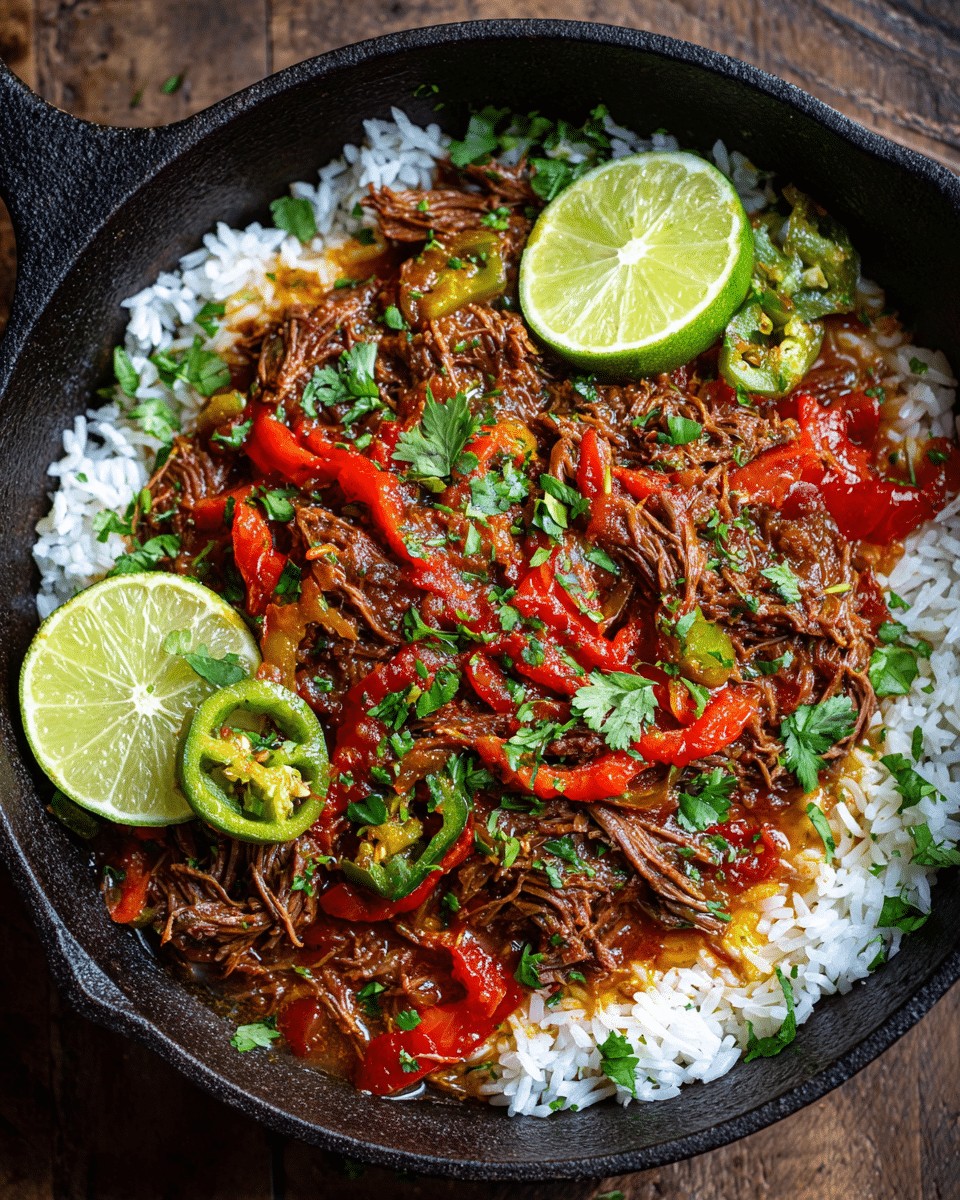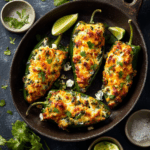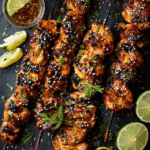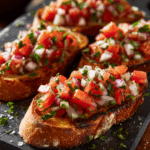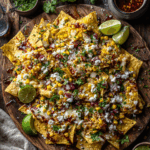Cuban Ropa Vieja is a beloved classic dish known for its tender, shredded beef simmered in a rich, tomato-based sauce infused with peppers, onions, and a blend of traditional Cuban spices. Translating to “old clothes” due to the appearance of the shredded meat, this hearty stew is a staple in Cuban households and symbolizes comfort and family tradition.
FULL RECIPE
Ingredients
- 2 lbs flank steak or beef brisket
- 2 tablespoons olive oil
- 1 large onion, thinly sliced
- 1 large green bell pepper, thinly sliced
- 1 large red bell pepper, thinly sliced
- 4 cloves garlic, minced
- 1 (14 oz) can crushed tomatoes
- 1 (8 oz) can tomato sauce
- 1 cup beef broth
- 1/2 cup dry white wine (optional)
- 2 teaspoons ground cumin
- 1 teaspoon smoked paprika
- 1 teaspoon dried oregano
- 1/2 teaspoon ground black pepper
- 1/2 teaspoon salt (adjust to taste)
- 2 bay leaves
- 1/4 cup chopped fresh cilantro (for garnish)
- Juice of 1 lime
- Cooked white rice, for serving
Directions
- In a large pot or Dutch oven, heat olive oil over medium-high heat. Brown the flank steak on all sides, about 4 minutes per side. Remove the meat and set aside.
- In the same pot, add the onions, green and red bell peppers, and garlic. Sauté until softened, about 5 minutes.
- Stir in crushed tomatoes, tomato sauce, beef broth, and white wine if using. Add cumin, smoked paprika, oregano, salt, black pepper, and bay leaves. Mix well.
- Return the browned beef to the pot, cover, and reduce heat to low. Simmer for about 2 to 3 hours, or until the meat is tender and easily shredded.
- Remove the meat from the pot and shred it using two forks. Discard bay leaves.
- Return the shredded meat to the sauce and stir well to combine. Simmer uncovered for another 15 minutes to thicken the sauce.
- Stir in lime juice and adjust seasoning if needed.
- Garnish with fresh cilantro and serve hot over white rice.
Nutrition Facts
- Calories: 360
- Total Fat: 14g
- Saturated Fat: 5g
- Cholesterol: 90mg
- Sodium: 480mg
- Total Carbohydrates: 12g
- Dietary Fiber: 3g
- Sugars: 6g
- Protein: 38g
- Vitamin A: 35% DV
- Vitamin C: 40% DV
- Iron: 30% DV
History and Cultural Significance
Ropa Vieja is one of the most iconic dishes in Cuban cuisine, with origins tracing back to the Canary Islands and Spain. The name “Ropa Vieja” means “old clothes” in Spanish, a reference to the shredded appearance of the meat that resembles torn fabric. The dish became popular in Cuba due to its affordable ingredients and the ability to feed large families. It symbolizes comfort, home cooking, and Cuban heritage, often served during family gatherings and festive occasions. Its rich flavors reflect the blend of Spanish, African, and Caribbean culinary influences found in Cuban culture.
Flavor Profile and Key Ingredients
The flavor of Cuban Ropa Vieja is robust and layered, combining savory, tangy, and slightly smoky notes. The slow-cooked beef soaks up the acidity of tomatoes and the sweetness of sautéed bell peppers and onions. Spices like cumin, oregano, and smoked paprika contribute warmth and depth, while garlic enhances the overall aroma. The use of lime juice at the end adds a bright freshness, balancing the richness of the beef and sauce. The tender, shredded meat blends perfectly with the vibrant, saucy base, creating a satisfying harmony of flavors.
Health Benefits
While Ropa Vieja is traditionally a hearty and indulgent dish, it can also offer nutritional benefits. The beef provides a rich source of protein, essential for muscle repair and overall body function. The inclusion of colorful vegetables like bell peppers and onions adds vitamins, antioxidants, and dietary fiber, supporting immune health and digestion. By controlling the amount of oil and salt used, this dish can fit into a balanced diet. When served with whole grain rice or beans, it becomes a complete meal rich in complex carbohydrates and plant-based nutrients.
Traditional Cooking Techniques
Ropa Vieja relies heavily on slow cooking to achieve its signature tender texture and rich flavor. The method of simmering the beef for several hours breaks down the connective tissues, allowing it to shred easily and absorb the sauce. Browning the meat first develops a caramelized crust, enhancing the dish’s depth. The layering of sautéed peppers, onions, and garlic creates a flavorful base that complements the meat. This classic approach showcases the importance of patience and attention to detail in traditional Cuban home cooking.
Variations and Regional Differences
Although the basic recipe remains consistent, there are numerous variations of Ropa Vieja across Cuba and other Latin American countries. Some versions include additional vegetables such as olives or capers for a briny twist, while others might substitute flank steak with brisket or chuck roast. In Puerto Rico, a similar dish incorporates sofrito, a fragrant blend of peppers, onions, and herbs. Some cooks add a splash of sherry or white wine to enrich the sauce. These adaptations reflect regional tastes and ingredient availability, demonstrating the dish’s versatility.
Serving Suggestions
Ropa Vieja is traditionally served over fluffy white rice, which soaks up the flavorful sauce. It’s often accompanied by black beans, fried plantains (tostones or maduros), and a simple green salad to balance the richness. For a festive meal, some pair it with yuca or root vegetables. Garnishing with fresh cilantro or a squeeze of lime can brighten the dish further. Because of its hearty nature, it pairs well with light, refreshing beverages such as citrusy cocktails or cold beers.
Pairing with Beverages
The bold flavors of Ropa Vieja call for beverages that complement its complexity. Traditional Cuban drinks like mojitos or Cuba libres provide a refreshing contrast with their citrus and mint notes. For non-alcoholic options, sparkling water with lime or tropical fruit juices works well. If you prefer wine, a medium-bodied red such as Tempranillo or Merlot balances the savory richness. The carbonation and acidity of these drinks help cleanse the palate between bites.
Storage and Leftover Tips
Ropa Vieja is an excellent dish for meal prep, as its flavors often deepen after sitting overnight. Store leftovers in an airtight container in the refrigerator for up to 4 days. When reheating, do so gently over low heat to preserve the tenderness of the meat and avoid drying out the sauce. It can also be frozen for up to 3 months; thaw it overnight in the fridge before reheating. Leftovers can be repurposed in sandwiches, tacos, or even as a filling for savory empanadas, making the most of this versatile dish.
Common Mistakes to Avoid
A common mistake when making Ropa Vieja is rushing the cooking process. The beef must be cooked slowly to break down the fibers and achieve that perfect shreddable texture. Using a tougher cut without sufficient cooking time results in chewy meat. Over-soaking or overcooking the peppers and onions can lead to a mushy texture, which detracts from the dish’s balance. Lastly, neglecting to season in layers—both the meat and the sauce—can result in a bland final product. Proper seasoning and patience are key.
Advertisement
Tips for Enhancing Flavor
To maximize flavor, start by searing the beef well to develop a deep brown crust. Use fresh spices rather than pre-ground for more vibrant notes. Adding a splash of white wine or vinegar can elevate the sauce’s complexity. Layer your sautéed vegetables carefully to build sweetness and umami. Letting the dish rest and marinate in the fridge overnight allows the flavors to meld beautifully. When serving, a fresh squeeze of lime juice and a sprinkle of chopped cilantro add brightness and freshness that enhance the overall experience.
Conclusion
Cuban Ropa Vieja is more than just a comforting meal—it’s a celebration of Cuban culture and culinary tradition. Its rich history, robust flavor, and adaptable nature have made it a beloved dish far beyond Cuba’s borders. Whether you enjoy it as a hearty family dinner or an impressive dish for guests, Ropa Vieja delivers deep, satisfying flavors with every tender, shredded bite.

